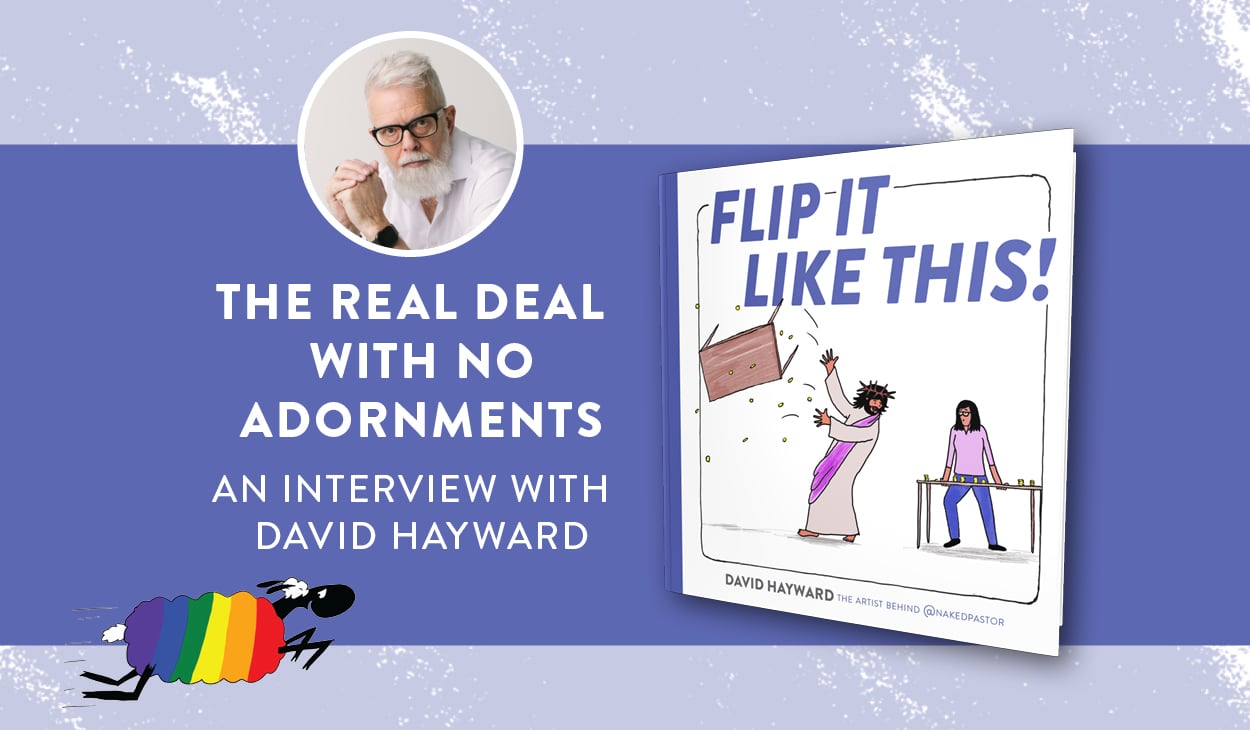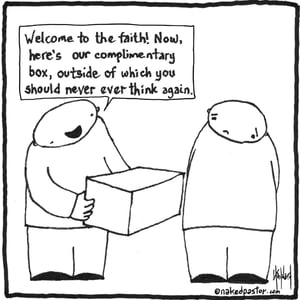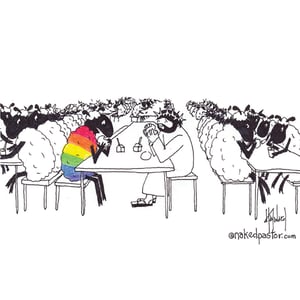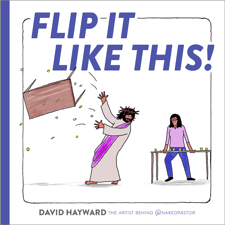David Hayward is the author of Flip It Like This! and the artist behind @NakedPastor. We asked David a few questions to learn more about the inspiration behind his new collection of cartoons that directly address today’s pressing issues of inclusion, faith, spiritual abuse, and justice.
What led you to release Flip It Like This!, your new collection of cartoons?
I’ve been drawing cartoons since 2005, at a rate of about one per day. That gives me thousands of cartoons that I’ve shared on my social media platforms. I’ve published other books of cartoons, but they have been more issue oriented. I figured it was about time a book of the “best of” NakedPastor cartoons was offered to the world.
Would you explain the reasoning behind the name “NakedPastor”?
When I started blogging in 2005, I used the website name DavidHayward. So boring! There were a lot of other pastors blogging at that time. I wanted mine to be different, unique, and special. I decided that I was going to be completely authentic, transparent, honest, vulnerable, raw, and real on my blog. I was going to pull back the curtain on the life of a pastor and let everyone see what goes on behind the scenes . . . not just the good things with church growth, great music, comfortable seating, great coffee and donuts, awesome preaching and potlucks and harmonious fellowship. I was going to let them see the struggles . . . the conflicts, doubts, mistakes, questions, and defeats. Hence “NakedPastor”: the real deal with no adornments.
Who is the target audience for this book?
The largest demographic of my audience is people between the ages of 24 and 45, with the majority of them being women. However, people of all ages appreciate, collect, and share my cartoons. I’m also sure that most of my audience are people who are questioning their beliefs, their faith, and their relationship to the church—including pastors and churches! So, generally speaking, my target audience is people who will appreciate my cartoons that provoke thought about spirituality and organized religion in sometimes poignant, sad, infuriating, and funny ways.
Your path has taken many turns, including a long career in ministry. How did you find your way to using art to share your message?
Many years ago when I was an ordained minister in the Presbyterian Church in Canada, we had what was called the “children’s story” in services. I sometimes used that opportunity to draw a story on a flip chart. I noticed that not only did the kids love it, but the adults did too. Then, in 2005, when I started to try using cartoons to convey my thoughts and feelings, I noticed how quickly they caught on. People either loved them or hated them. But so many people saw them. They are often one frame with few, if any, words. So it takes a split second to see it. Then it’s too late! It has snuck its way inside you, and you can’t unsee it. Art is a powerful way to explore who we are and to communicate meaning in such a direct and rapid way that bypasses our intellectual, psychological, emotional, and spiritual defenses.
What has the response from readers been like? Are you finding a community ready for your message?
Definitely! For instance, my Instagram account has more than 102,000 followers. Then there are all the followers on all the other platforms and the thousands on my mailing list as well. I’m discovering people all over the world who appreciate my work and share it with family, friends, and groups they are a part of. What’s really cool about it is that they aren’t just a scattered bunch of people. Once we find one another, like on Instagram, we interact and often become friends. It’s quite a powerful illustration of how love, inclusion, openness, and diversity really do make a great recipe for authentic community.
Your cartoons reach a lot of different audiences and bring in readers from across the religious landscape. Do you have theories about why your cartoons speak so widely?
I have a couple of theories about why my cartoons are appreciated around the world. One is that they are simple. They are often one frame, with either no or few words, so that there’s no need for extensive translation or cross-cultural communication. Second, they speak to a universal cry from so many people for freedom: freedom to be and to express their authentic selves. Some countries and cultures provide more space for this than others, and I hear this struggle in the voices of so many people. But we’re seeing it more and more: a longing for liberty!
People often ask you to say what you believe and/or how you identify in terms of faith commitments. How do you respond to that question—and perhaps more importantly, why are people so interested in your answer?
I’ve concluded that people often ask me this question because they need to see what label I wear so that they know how to relate to me. My spirituality has taken me in a direction of really believing that we are all one at a deep and fundamental level: that there is one reality that we all share, but we apprehend and articulate it according to our own conditioning, experience, and knowledge. These different thoughts seem to divide us into camps, tribes, denominations, religions, and groups. But beneath all this is this oneness that is established. The reconciliation of all things—this is what I focus on. But most of us require people to be like us or we can’t understand, accept, include, fellowship with, or communicate with them.
Describe your creative process. Do you often sit down with no idea what you’re going to draw, or do you usually have a good idea where you’re going to start?
My creative process varies. Sometimes I wake up in the morning with an idea. Sometimes I have to get back up out of bed just as I’m going to sleep because an idea comes to me. Most often, though, I get up, take care of my dog, make coffee, put on music, contemplate, read, and write in my journal, then get to work. I try to draw a new cartoon every day. And I try to post it at 9 am. So I’m up early, and after my morning routine, the pressure is on to create. It’s fast and furious, but fun! My paintings and drawings are a different process altogether: much slower, meditative, and serene.
Do you do other types of art in addition to your cartoons? Do your cartoons come from the same place inside you that your paintings do, or are they categorically different?
Good question! I think all my creativity comes from one source, and that is my passion for freedom. In my cartoons I draw about freedom—how to live it but also how to give it. I try to speak truth to power that would try to manipulate, manage, and control people, limiting their freedom. Here I’m quite merciless in my criticism. And I show happy cartoons of characters demanding and living their freedom, often to the dismay of others. My paintings are about freedom, too. This is symbolized by spaciousness. There’s a lot of negative space in my paintings. And often the vast, minimalist landscapes include a solitary individual: alone but not lonely, living their freedom symbolized by solitude and serenity. I call my cartoons my “contentious” side, and my paintings my “contemplative” side. But they are two sides of one coin: freedom!
Click here to learn more about Flip It Like This! by David Hayward.





